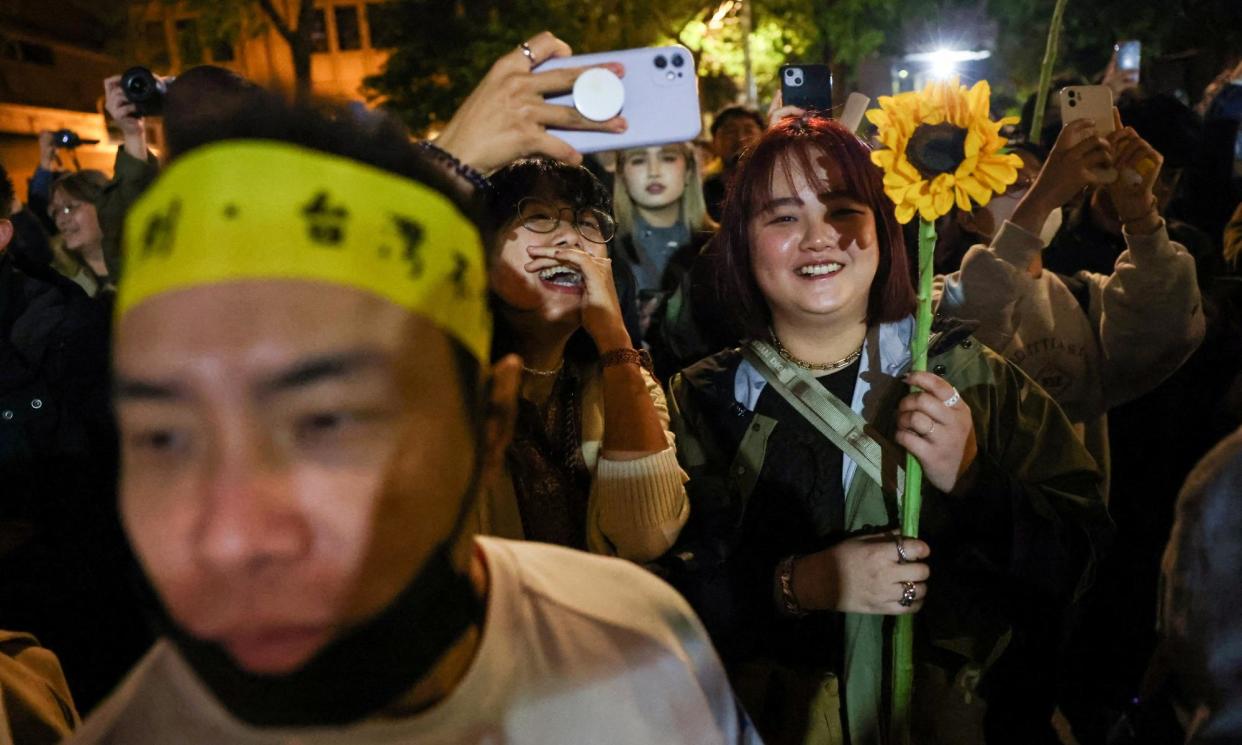How the Sunflower movement birthed a generation determined to protect Taiwan

Rushing over walls and through doors, they clambered into the parliamentary chamber, crowding the halls with placards, while piling chairs against the door as barricades against police.
Hundreds of young people, mostly Taiwanese university students, were storming Taipei’s national legislature.
They had been gathered outside the government building to protest against the government’s attempts to ram through a trade treaty between Taiwan and China that – in the eyes of the students – would put their homeland at further risk from Beijing.
Related: Taiwan revels in its young democracy as president-elect charts fresh course
The occupation and adjoining street protests of 2014 became known as the Sunflower movement and lasted more than three weeks, ending only when the controversial bill was withdrawn.
A decade on, it’s being remembered as a victory that radically changed Taiwan’s political democracy, birthing a new generation of young idealistic politicians while holding vital lessons further afield, for Hong Kong and Ukraine.
‘If we don’t fight for ourselves, no one will’
Before the eventual victory, the protesters inside the national legislature had to figure out food and sanitation. The storming had been planned, but, says Brian Hioe, a Taiwanese activist and now political writer and commentator, they hadn’t entirely expected to be successful.
The legislature became a mini-city, not unlike the 2011 Occupy Wall Street protests seen earlier in the US, or those seen later that year in Hong Kong, and again in 2019. Security and media teams were set up and factions formed as decision-making became more centralised in a small circle of protest leaders.
The then opposition Democratic Progressive party (DPP) seized the moment, and party members – including the now president Tsai Ing-wen and vice-president-elect Hsiao Bi-Khim – mobilised to protect the protesters and their sit-in.
The later storming of another government building on 23 March, saw violent crackdown by police and more than 100 arrests. A week later somewhere between 110,000 (the police estimate), and half a million (the organisers’ estimate) rallied outside the presidential building, in support of the movement.
On 6 April, parliamentary speaker Wang Jin-pyng conceded to the protesters’ demand, announcing the bill would not be put to the legislature until there were public oversight mechanisms in place. After 23 days, protesters agreed to disperse.
There was minimal international attention on the protests. At the same time the students were occupying Taiwan’s legislature, much of the world’s focus was elsewhere, including the Maidan revolution in Ukraine and then Russia’s annexation of Crimea. The world was also gripped by the disappearance of flight MH370, 10 days before the Sunflower protests started. Just months later, Hong Kong’s Umbrella protesters staged a months-long occupation of central city streets.
Lin Fei-fan, a Sunflower movement leader, says there were – and still are – clear parallels between Ukraine, Taiwan and Hong Kong. “Ukraine and Taiwan were facing the same question: join the world or become in orbit of an authoritarian state. Hong Kong was in that orbit already, but was still fighting for their autonomy and democracy.”
He says the few outsiders watching Taiwan were pessimistic, citing a widely shared article about China’s threats to its sovereignty headlined “Say Goodbye to Taiwan”. Protesters were driven by an understanding that “if we don’t fight for ourselves, no one will”.
Ten years on from the protests, Taiwan is still under threat but is a boisterous democracy, increasingly resistant to Chinese rule. In Hong Kong, dissent and opposition has been almost entirely crushed by the city’s government and China’s ruling Communist party (CCP).
“I think the basic difference is sadly whether or not you have sovereignty,” says Lin of the divergent paths.
“One lesson we can learn from Hong Kong is that even in that situation there still are many, many young Hongkongers who are not giving up … We don’t want Taiwan to face the situation Hong Kong faced, we really need to keep that kind of spirit and determination to grow in Taiwan.”
After the protests, several Sunflower movement activists went into formal politics. Some formed new parties while others like Lin joined the DPP – which two years later resoundingly defeated the Kuomintang (KMT) in district and national elections, and is still in power. Taipei city councillor Miao Po-ya told local media this week that the protests drove the youth vote and political engagement.
Hioe notes a network of international solidarity groups formed in the protests’ wake. “Basically, anywhere there was a gathering of Taiwanese students, organisations would form.”
The challenge now for the DPP is holding on to the youth vote. Gen Z Taiwanese have grown up under DPP rule, and there was a visible shift to the newly formed populist Taiwan People’s party in January’s election.
On Monday evening, protesters gathered again outside the legislature, to mark the past decade. Placards opposed resumption of the bill that sparked the protests – which the TPP had proposed during election campaigns – and criticised the KMT and CCP. “As long as the KMT does not fall, Taiwan will not be well,” read one.
Lin says the overarching impact of the movement was a new understanding that political decisions – especially those concerning China – shouldn’t be in the hands of an elite.
“Civil society has a role to influence policies, and we control our own fate.”


